After more than a month in China, we have to say this trip has been absolutely delightful in every sense of the word! We left the city of Xi’an to head to Chengdu, and after a deeply moving encounter on the train, we were even more excited when we arrived in Sichuan province. Ready to visit Chengdu? Here’s our guide to things to do (and no, it’s not just about pandas!).
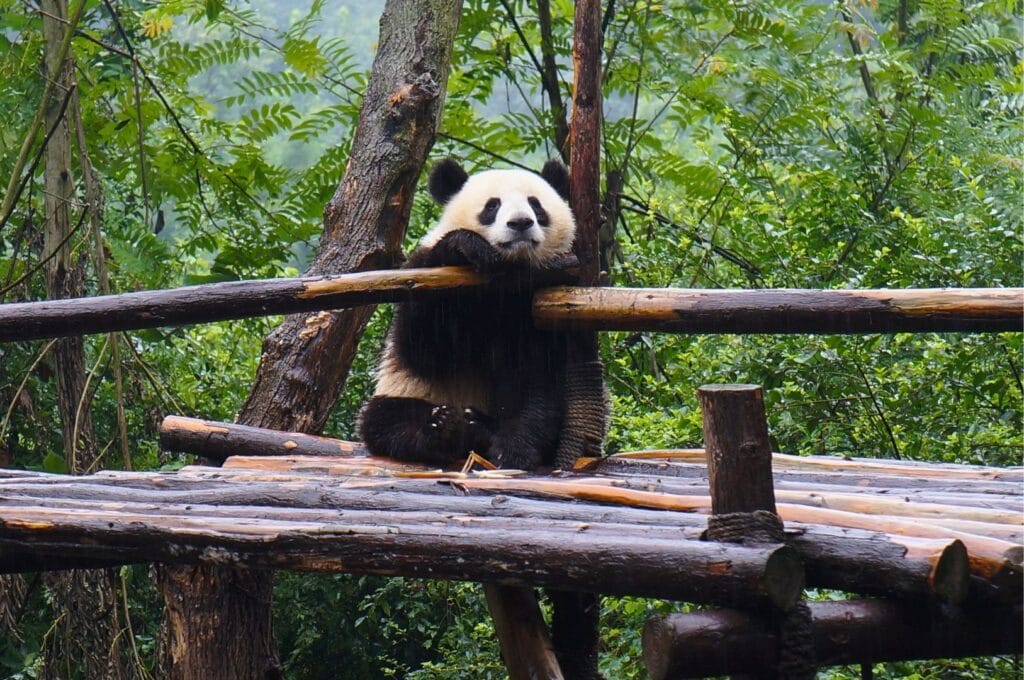
- Introduction to Chengdu, capital of Sichuan
- How to get to Chengdu
- Where to stay in Chengdu
- Visiting the Chengdu Research Base of Giant Panda Breeding
- Strolling through People’s Park
- Exploring Chengdu’s old town
- Attending a Sichuan opera performance
- Tasting Sichuan cuisine
- What to do around Chengdu
- Our Chengdu experience: final thoughts
We took this trip to Chengdu in 2013, but the article was completely revised and updated in August 2025. If you see any price changes or have additional information that might be relevant, please feel free to leave us a comment!
Introduction to Chengdu, capital of Sichuan
Sichuan is a Chinese province that’s often overlooked, but it has so much to offer! With its 3,000 years of history, incredible food scene, and rich culture, we won’t hide it from you – we fell head over heels in love with this place. We ended up staying for 3 weeks, and as you’ll see in upcoming articles, Sichuan is also an excellent way to get a good taste of Tibet without having to deal with all the administrative formalities.
Initially, we thought we’d only stay 2 or 3 days in Chengdu. In the end, an absolutely amazing couchsurfing host and our desire to rest a bit convinced us to extend our stay. So it was at a very relaxed pace that we decided to discover the capital of Sichuan.

How to get to Chengdu
From Xi’an
To reach Sichuan and Chengdu, we departed from Xi’an, and there are two options:
- High-speed train (bullet train): This takes about 3 hours and costs around 40 euros in second class.
- Night train: This takes between 10 and 15 hours! That’s quite a difference, but it costs between 25 and 50 euros in hard sleepers and saves you a night’s hotel accommodation ;).
From Emeishan
The train is also very convenient for reaching Chengdu from Emeishan. In addition to the regular train, there’s a high-speed train (bullet train) that gets you there in just 1 hour! Train tickets cost around 80-100 yuan per person. Find all train schedules online.
From Beijing
From Beijing, plane and train are the best transportation options to cover the 1,800 km to Chengdu!
By plane, prices are high for a direct 3-hour flight. Tickets cost around 900 yuan, about 109 euros.
By train, it’s different since you’ll need at least 7.5 hours from the Chinese capital to reach Chengdu. However, prices are almost equivalent to plane tickets – expect around 800 yuan. The only way to lower the cost is to opt for slow trains (1 day of travel) in hard sleepers. Check the timetables online.
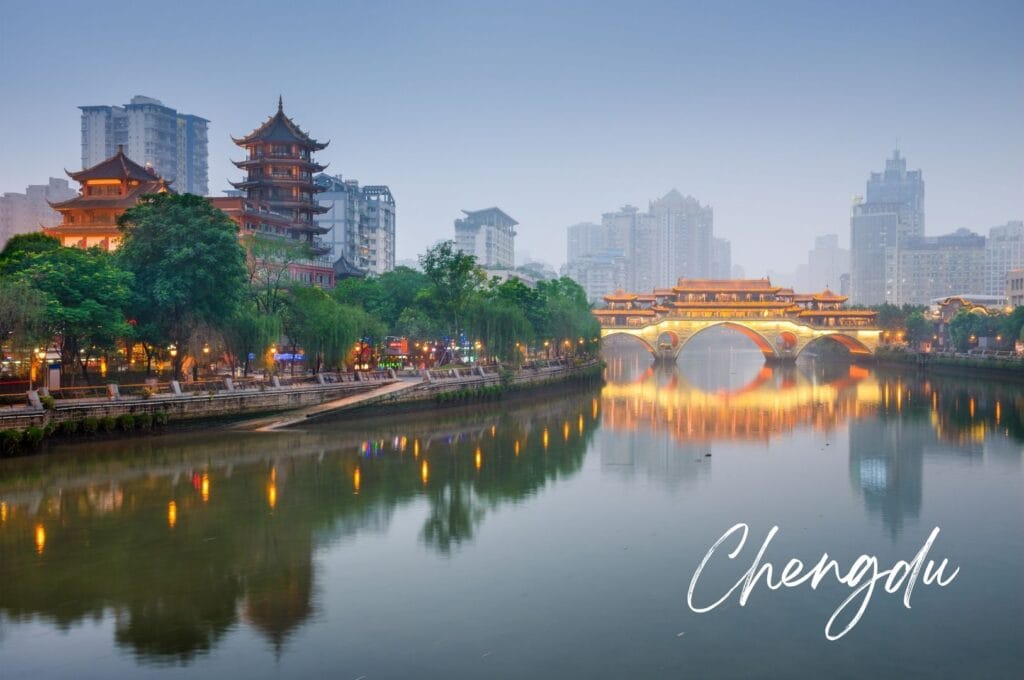
This article contains affiliate links to partner sites. When you use our links to book accommodation, a car, or an activity, you don’t pay anything extra, but we get a small commission. This helps us to offer you free, independent, and ad-free content. Thank you for your support!
Where to stay in Chengdu
As we mentioned at the beginning of this article, we did couchsurfing in Chengdu. In total, we spent 5 days with our host.
If you’re looking for accommodation in Chengdu, you have many options:
- Budget/Backpackers: Lazybones Hostel and Desti Youth Park Hostel probably offer the best value for money in the city! They’re well-located, the facilities are good, and the staff speaks English.
- Mid-range budget:
- Xishu Garden hostel was warmly recommended to us! It’s not the cheapest, but the services offered are top-notch. The establishment is impeccable, perfectly located in a lovely neighborhood close to transportation, and apparently, the breakfast (included in the price) is incredible. In short, if we returned to Chengdu, we’d probably stay at this place! You’ll find double rooms in addition to dormitory beds.
- For even more privacy, this apartment with a panoramic view of the city could be a good option. The price is more than reasonable for ultra-quality, well-located accommodation!
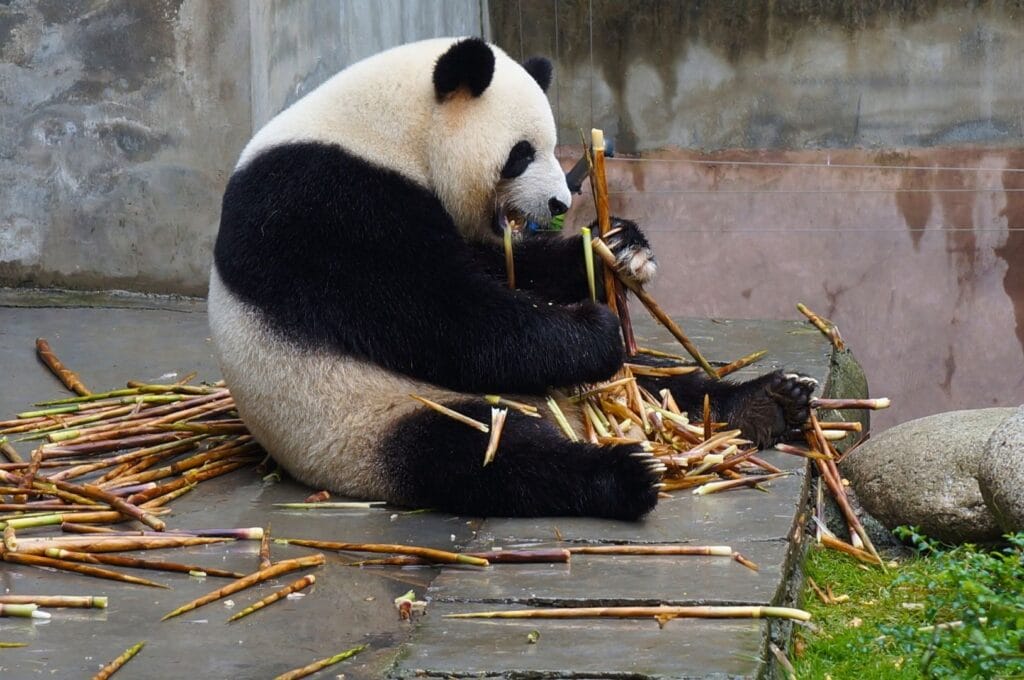
Visiting the Chengdu Research Base of Giant Panda Breeding
About the Panda Center
This is undoubtedly Chengdu’s main attraction! Many local and international visitors pass through the Chengdu Research Base of Giant Panda Breeding. We’re warning you – the site is massive at 238 hectares! Giant pandas, red pandas, baby pandas, a futuristic tower, and even golden monkeys… There’s plenty to keep you busy for half a day! Plan on a good 7-8 km walk to see it all.
Here is a map of the park to give you an idea of the size of the site. To download it, click on it.
The center is divided into two parts. You have the old section, all the area around the south gate (in light brown), and the new section, the yellow, green, blue, and orange zones. The most “famous” pandas are in the old section, while the largest number of pandas are in the new section. Most visitors start at the main entrance, the south gate, to see the celebrities. Therefore, if you want to see lots of pandas, we’d recommend entering through the west gate to enjoy the mammals without too many crowds, early in the morning.
Our review
I’m a bit of a kid when it comes to animals – I quickly become gaga over adorable little balls of fur. So Ben had no choice but to accompany me for a day that was punctuated by “Oh!!! Look! So cute!”
I fully accept the ridiculousness of the situation, especially since the Chengdu panda center somewhat reassured me about animal welfare conditions in China. In the park, animals aren’t behind bars but in large green spaces. Honestly, I found the space available to them much more adequate than what we see in many European zoos. Of course, they’re still animals in captivity, but failing to eliminate that entirely, I think many zoos could come here for inspiration.
Note: The site has expanded since our visit, and the authenticity has somewhat gone by the wayside. It’s now more of a protection center disguised as a tourist attraction.
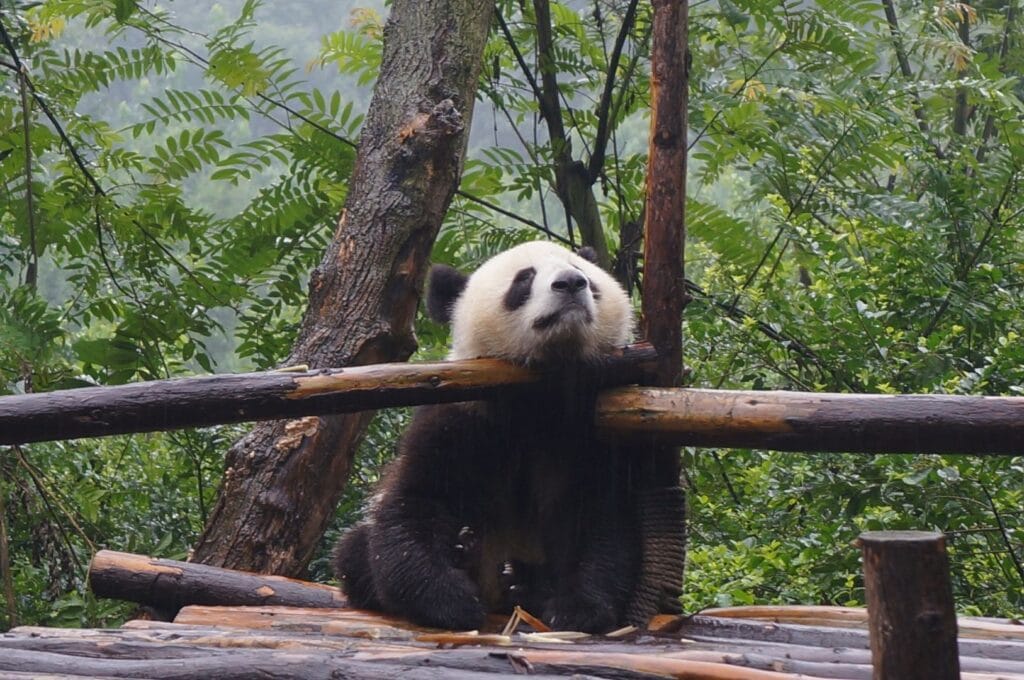

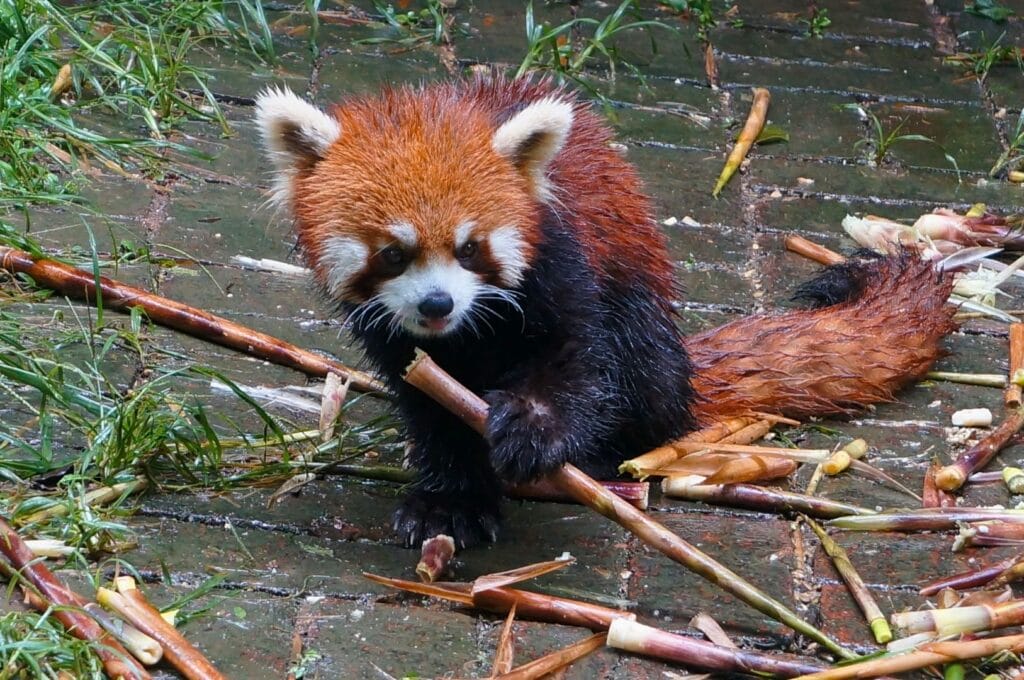

Animals in captivity
Visiting animals in captivity is generally not a good idea. We firmly believe animals are better in the wild than in zoos. However, in Chengdu, things are slightly different. This center is actually a non-profit organization, and ticket prices go back to the center for its proper functioning. The center’s objective is to contribute to panda reproduction.
Indeed, pandas are an endangered species, and their reproduction is VERY delicate. Two reasons for this: female pandas only ovulate once a year (yep…). The catch? Male pandas aren’t exactly hot-blooded lovers… Given the choice between eating and mating, they often prefer the first option! So this center takes care of monitoring the little ovules and inseminating the ladies while the gentlemen enjoy bamboo ;). So, even though the place has become a sort of panda Disneyworld with shops and all the trimmings, we have to acknowledge that this center contributes to species conservation.

Transportation
The giant panda research center is located 10 km from downtown Chengdu. To get there, you need to go to one of the 2 main entrances, the south gate or the west gate. In any case, the simplest way is to take public transport, especially the metro. A ticket costs less than 10 yuan per person.
For the west gate, take metro line 3 to Chengdu Junqu General Hospital Station and take exit B. Walk up the main street to this bus stop. From there, bus 409 will take you to the center.
For the south gate, it’s still line 3 you need to take, but get off one stop earlier, at Panda Avenue, exit A. Buses 408 and 198 go directly to the park.
Ticket prices and shuttles
Park admission costs 55 yuan per adult aged 18 to 59. It’s free for elderly people and discounted for children 6 to 18 years old (27 yuan). When booking, you must select a visit time slot: morning from 7:30 a.m. to noon or afternoon from noon to 6 p.m. Therefore, the visit takes half a day.
Paid shuttles run through the park for people who don’t want to walk everything. The ticket costs 30 yuan to pay on-site for up to 5 trips.
What if you stepped into the shoes of panda keepers? Participate in the volunteer program for a day at the Dujiangyan reserve. The program includes: accompanying keepers into the enclosure, preparing food, lunch with keepers and an English-speaking guide, etc.
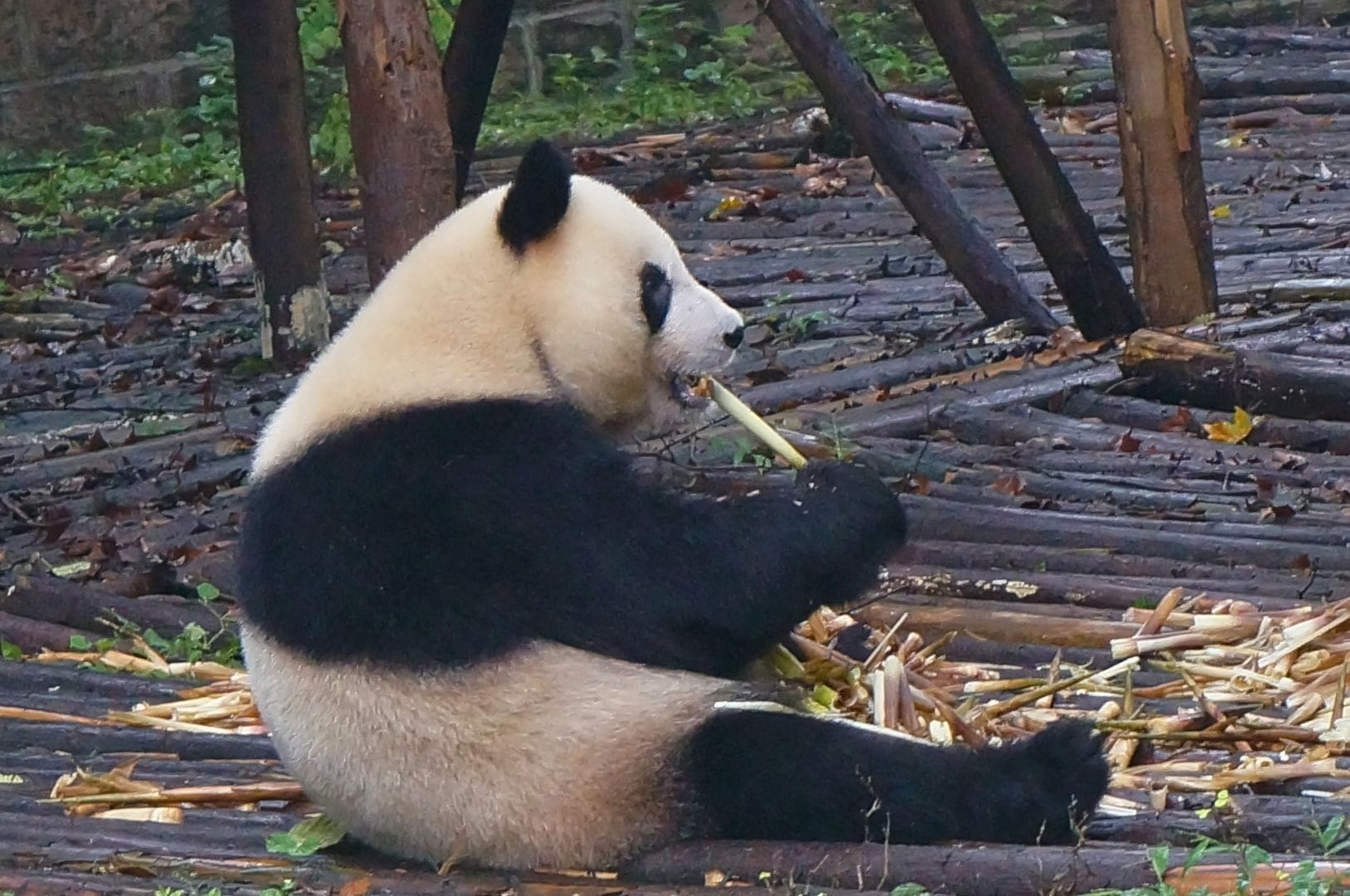
Opening hours
The Chengdu Giant Panda Breeding Research Center is open every day from 7:30 a.m. to 6 p.m. between March and October (high season) and from 8 a.m. to 5:30 p.m. the rest of the year. Please note, you can’t enter 1 hour before closing time.
Note: The bamboo tower is open every day except Tuesday, between 9 a.m. and 5 p.m. Entry is included in the center ticket.
Best season to see pandas
As with any trip to China, we don’t recommend visiting the pandas in summer! It’ll be packed, and since it’s hot, the pandas are inside, so you won’t see much! Go in spring or just after Golden Week to have more peace.
Also, pandas are more active in the morning, particularly before 11 a.m. Don’t hesitate to arrive right at opening to enjoy them without too many crowds. Last point: avoid weekends (this applies to any visit in China ;)).
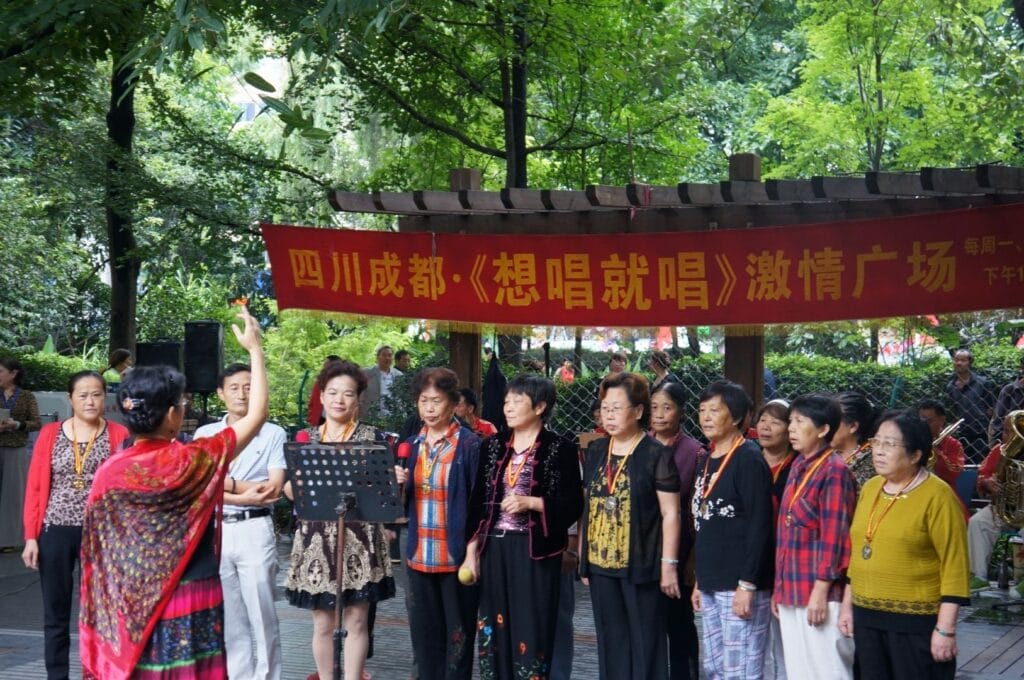
Strolling through People’s Park
Chengdu is a big city like many others in China. Although we must say we found the city center a bit more organized and clean than in other Chinese cities we’ve visited so far. Since the backpacks were heavy enough, we decided to resist the shopping temptation. Instead, we went to relax a bit in one of the city’s largest parks: People’s Park (Renmin Park)!
This park was really our big favorite in the city: several tea houses to taste delicious Sichuan tea, a large pond, but especially hundreds of people dancing, singing, doing tai chi, or exercising to music. Every little corner of the park is occupied by small groups. It’s a real treat for the eyes and ears (well, almost every time!).
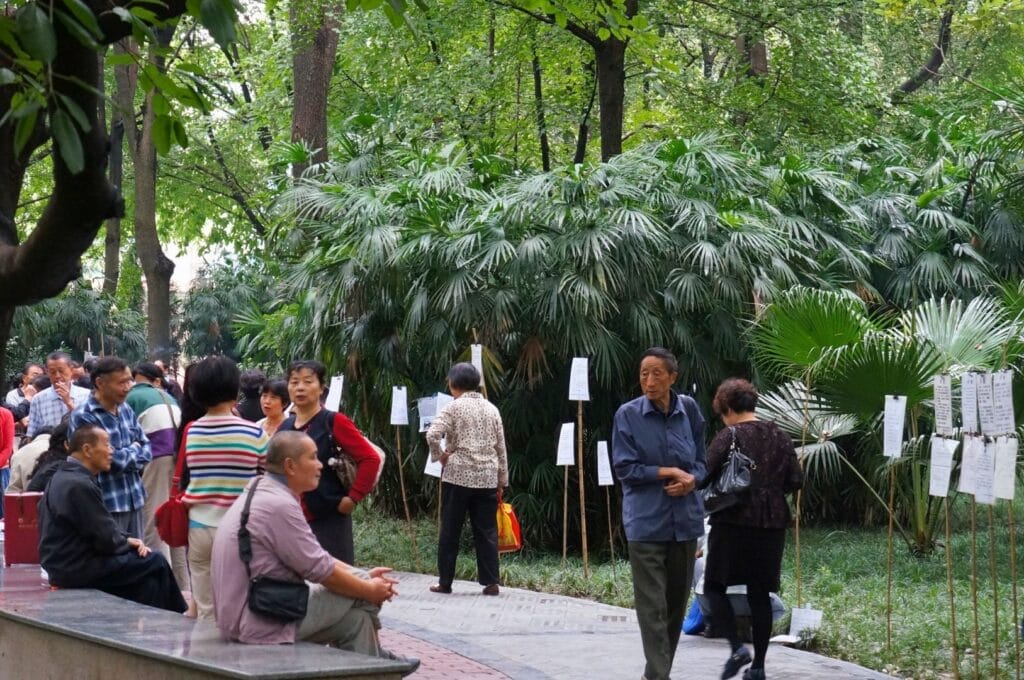
Tinder is for dummies
Another peculiarity of the park is the little alley reserved for parents of the city’s young singles! The concept is super simple. Do you have a single son or daughter you’d like to marry off? Then head to one of the park’s alleys and put up a little sign to present your offspring!
But be careful – no need to burden yourself with details like “nice, sociable, beautiful eyes, etc.!” In China, they get to the point. The main criteria? Height often comes first, then the job (it’s not uncommon to directly write the salary), whether they own their home, their origins, and finally, some hobbies. It was Yiou, our couchsurfing host, who explained the system to us in more detail. Luckily for him, his parents don’t live in Chengdu. Otherwise, it’s quite likely his mom would have tried to set up her 34-year-old single son!
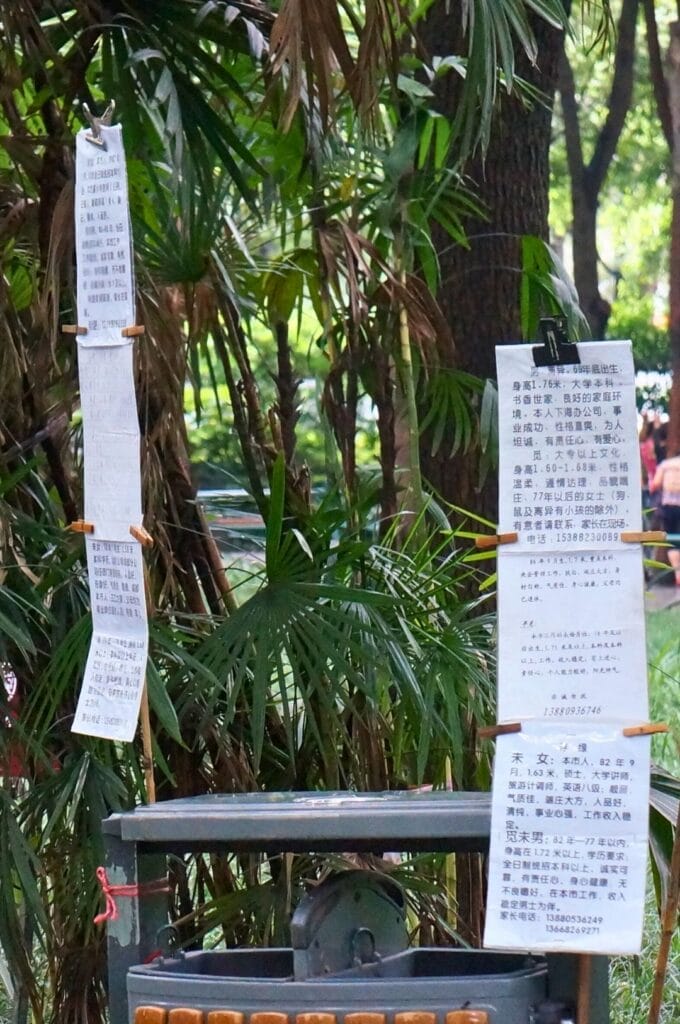
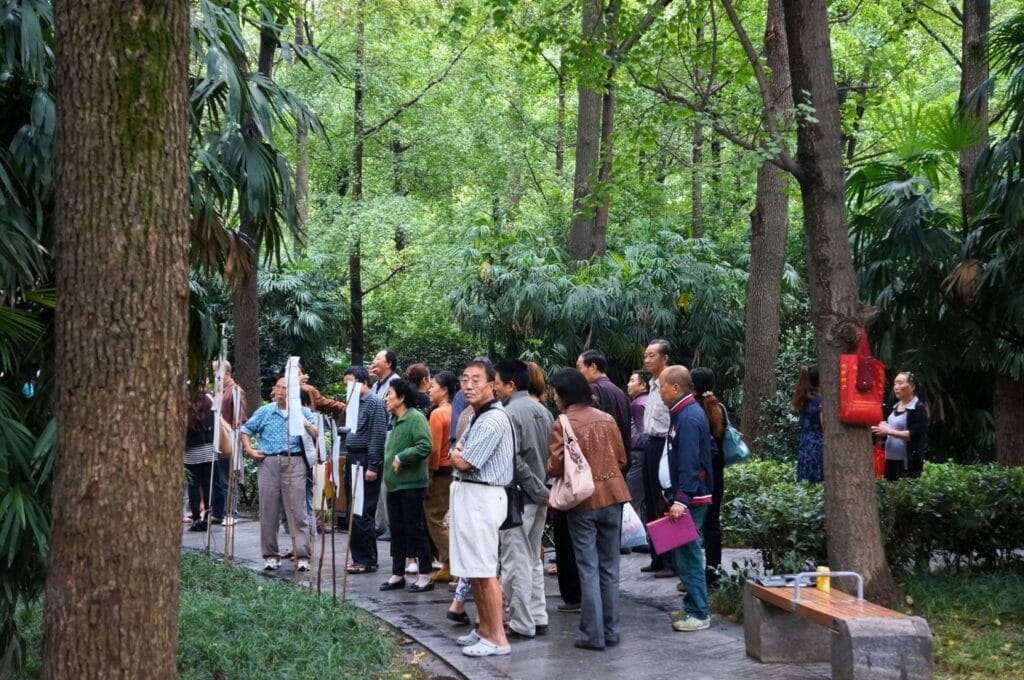
We crossed this alley on a Friday, and according to Yiou, it’s the liveliest day. It’s kind of the last moment to find a little date for the weekend. So when we passed by, we could admire dozens and dozens of people in their fifties with paper and pen in hand, taking notes and exchanging numbers with other parents! Oh my, business indeed!
Practical information
People’s Park is located right next to the Kuan and Zhai alleys, typical streets of the old town. To get there, take the Chengdu metro line 2 and get off at People’s Park station.
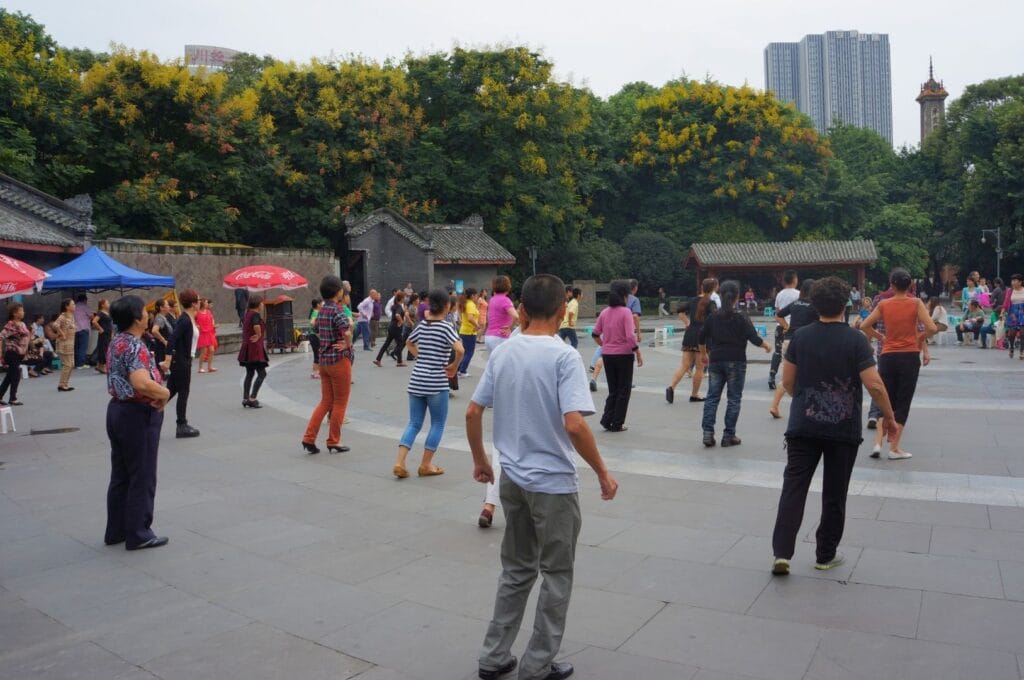
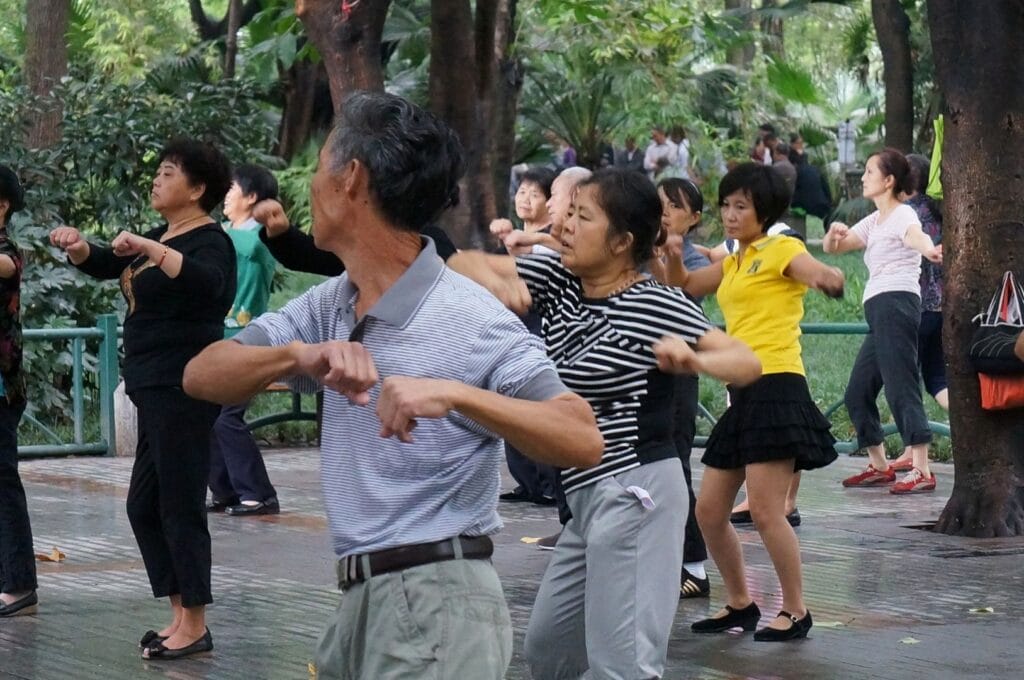
Exploring Chengdu’s old town
Pedestrian streets
Chengdu isn’t just pandas and People’s Park – it’s also an old town full of charm. Its pedestrian streets, shops, artisans, tea houses, street food… Don’t miss taking a tour! The historic center extends around the Kuanzhaixiangzi Alleys station on the Chengdu metro line 4. Stroll down the main street, Kuanxiangzi, and the surrounding streets. Further south, another historic pedestrian street is Jinli Street, located along the park containing Wuhou Temple. Finally, you’ll find pedestrian alleys right next to Wenshu Monastery.
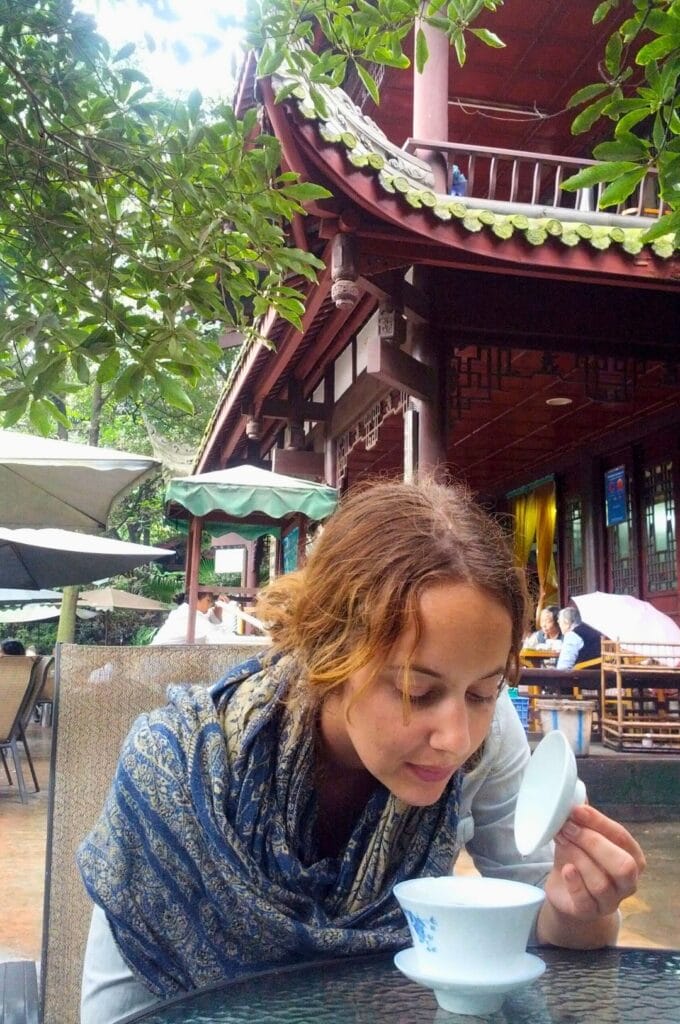
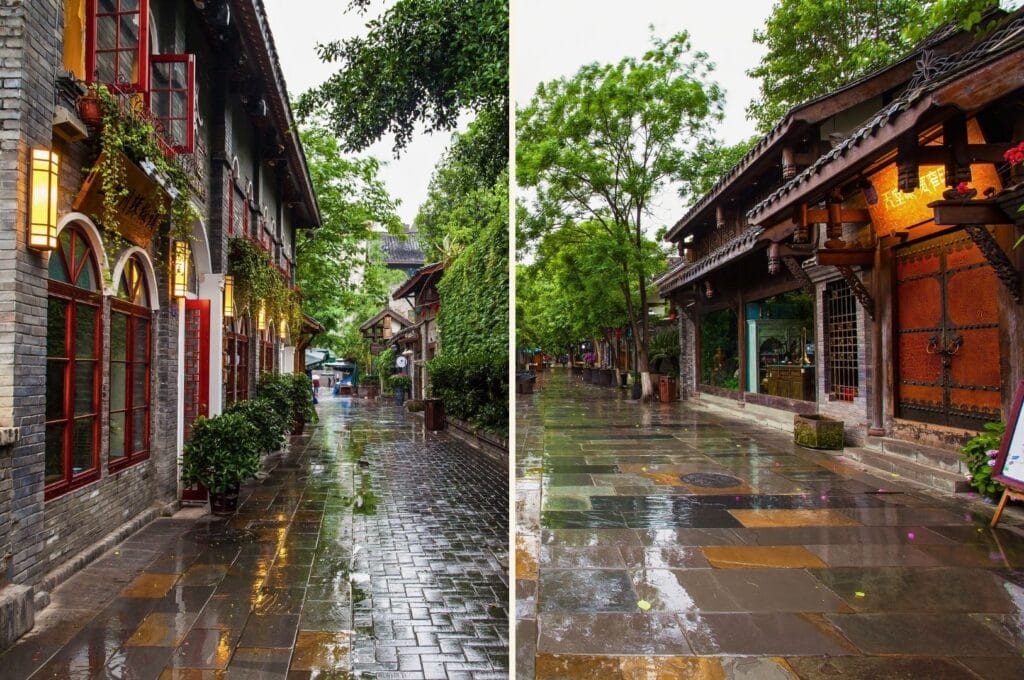
Wuhou Temple
The Temple of the Marquis of Wu, or Wuhou Temple, is dedicated to Emperor Liu Bei and Zhuge Liang, his famous strategist. The former reigned over the Shu kingdom, one of the 3 kingdoms that divided China in the 3rd century. Known for its traditional architecture, statues, and steles, the temple is located in the heart of a magnificent park of over 30,000 m2. We can only recommend taking a tour for a historical and peaceful walk.
Practical information: Wuhou Temple is open every day from 8:30 a.m. to 6:30 p.m. Entry costs 50 yuan per person (25 yuan for children 6 to 18 years old). To access it, take metro line 3 or 5 and get off at exit A of Gaoshengqiao station. It’s just a few minutes’ walk to the Wuhou Temple park.
Tip: The site is very popular with travelers to Chengdu. Go early in the morning or late afternoon!
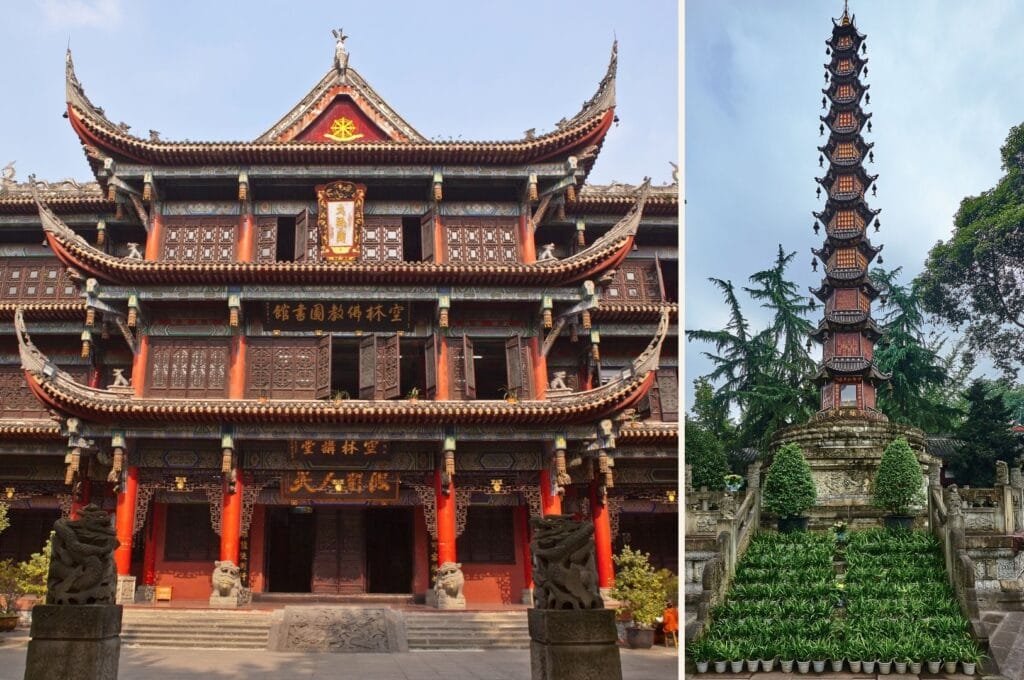
Wenshu Monastery
The Wenshu Monastery is a Buddhist temple surrounded by a magnificent garden. Originally built around 600 AD, it’s one of the oldest and largest Buddhist temples in the city. Popular with tourists and faithful alike, the place invites you to slow down and soak up the peaceful atmosphere. In our opinion, it’s a must-see in Chengdu!
Practical Information: Located north of downtown, in a historic district, Wenshu Monastery is close to the Wenshu Monastery station on metro line 1. For once, entry is free!
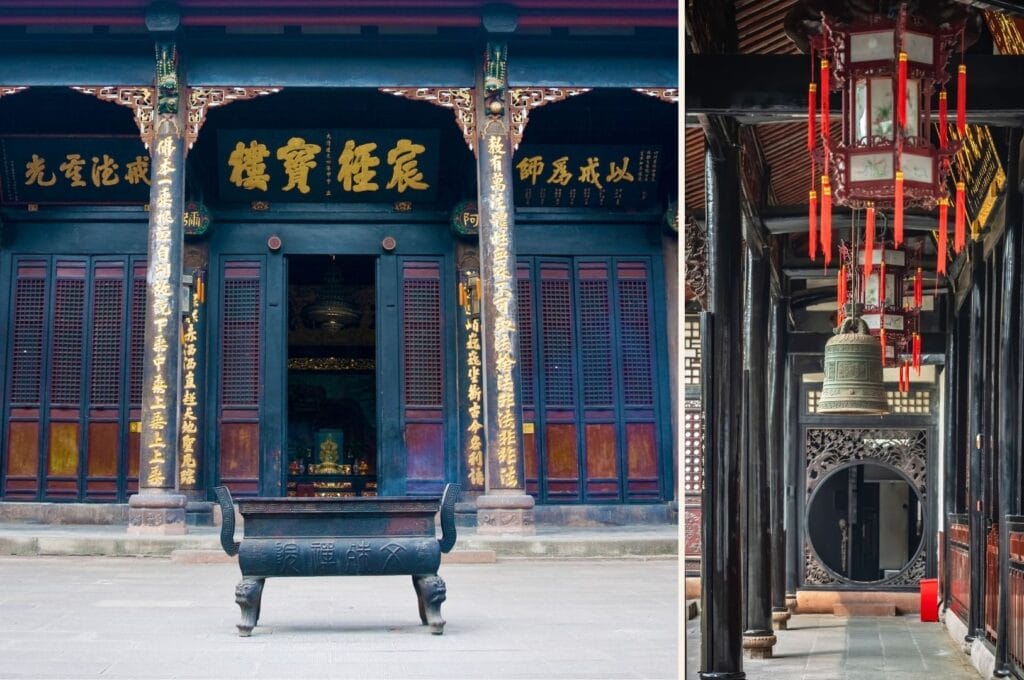
Qingyang Temple
After Buddhism, it’s time for Taoism! Qingyang is one of China’s oldest Taoist temples! It also dates from the Tang dynasty, a period when Taoism was expanding rapidly. Inside, you’ll find many relics with explanations in English. Here too, you can walk in the large park surrounding the building and enjoy tea.
Practical Information: Qingyang Temple is next to the Qingyang Taoist Temple station on the Chengdu metro line 5. The ticket price is 10 yuan.
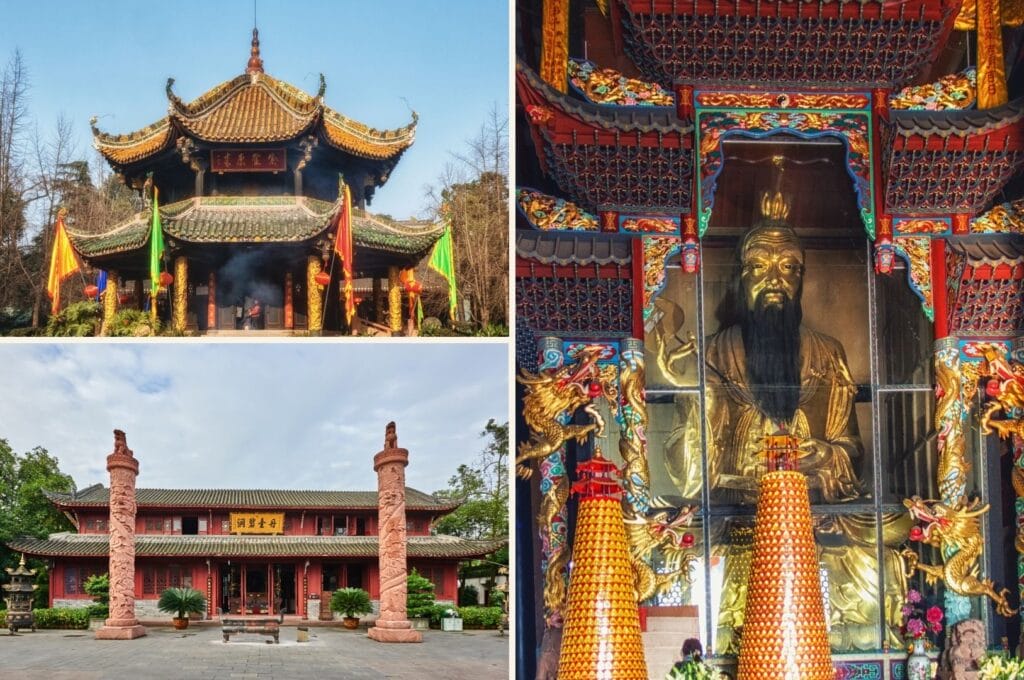
Attending a Sichuan opera performance
We didn’t do this, but it’s worth it! For 1 hour, you’ll watch in this old tea house a concert, acrobatics, theater, Chinese shadow puppetry, and the highlight of this traditionnal show – face changing in 1 second! In short, Sichuan opera is a real dive into the art, history, and culture of the region. It’s highly recommended to book your ticket online. As a bonus, you get a free massage or ear cleaning (yes, really!).
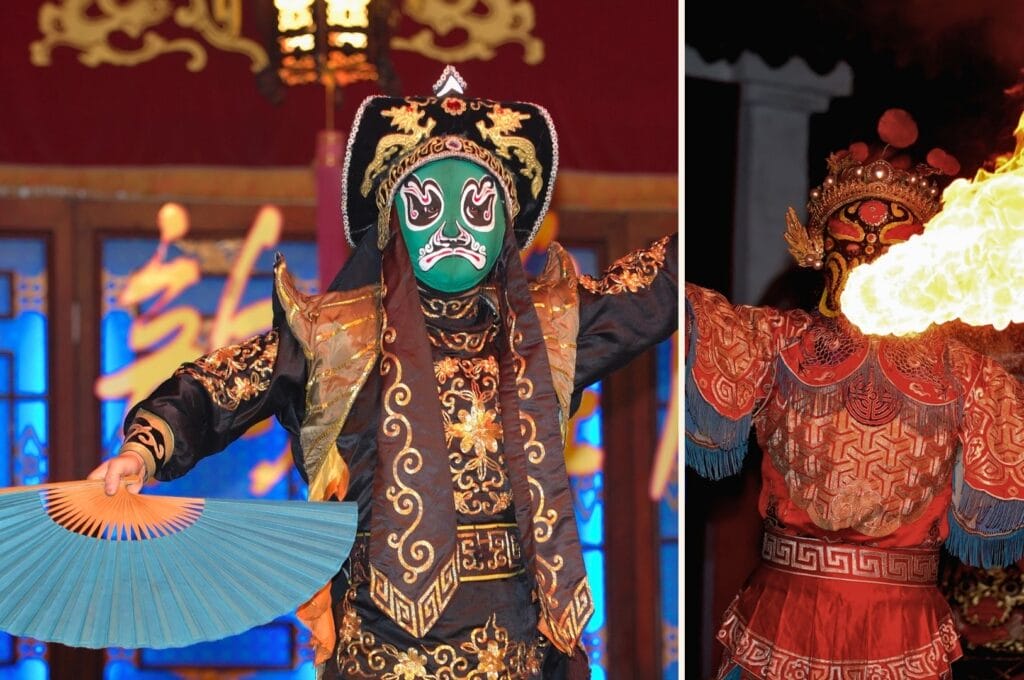
Tasting Sichuan cuisine
Another big thank you to our host Yiou, aka Frank for Europeans, for his welcome and also for taking us to all sorts of super nice restaurants we probably never would have set foot in without him! Indeed, Chengdu is considered a gastronomic capital, and we recommend stepping through the door of one of the typical restaurants to taste Sichuan cuisine! Among the must-try dishes, we recommend:
- hot pot (huoguo): you dip meat and vegetables in flavored broth;
- mapo tofu (simmered tofu);
- gongbao jiding (peanut chicken);
- wontons, a sort of Chinese ravioli stuffed with meat and vegetables…
We’re warning you – expect it to be relatively spicy! To go further, we wrote a whole article on the 10 commandments of Chinese cuisine ;).
Want to go on a food tour or take a Chinese cooking class in Chengdu? It won’t be quite the same as the one we did with our Couchsurfing host, but it could be a unique way to see the city ;). Find all the activities related to Sichuan food here.
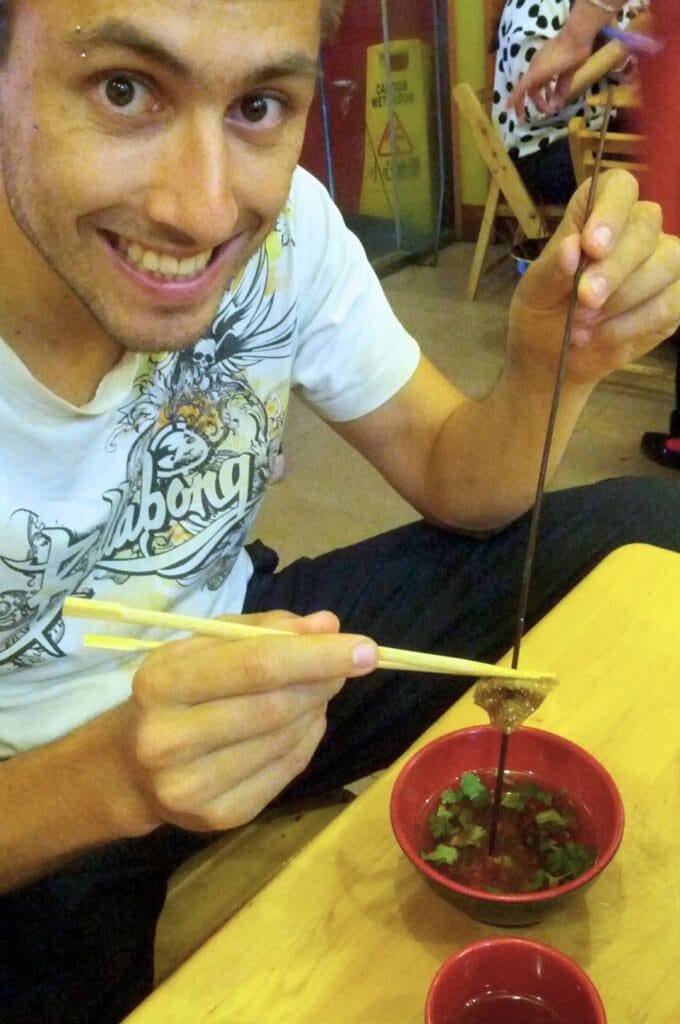

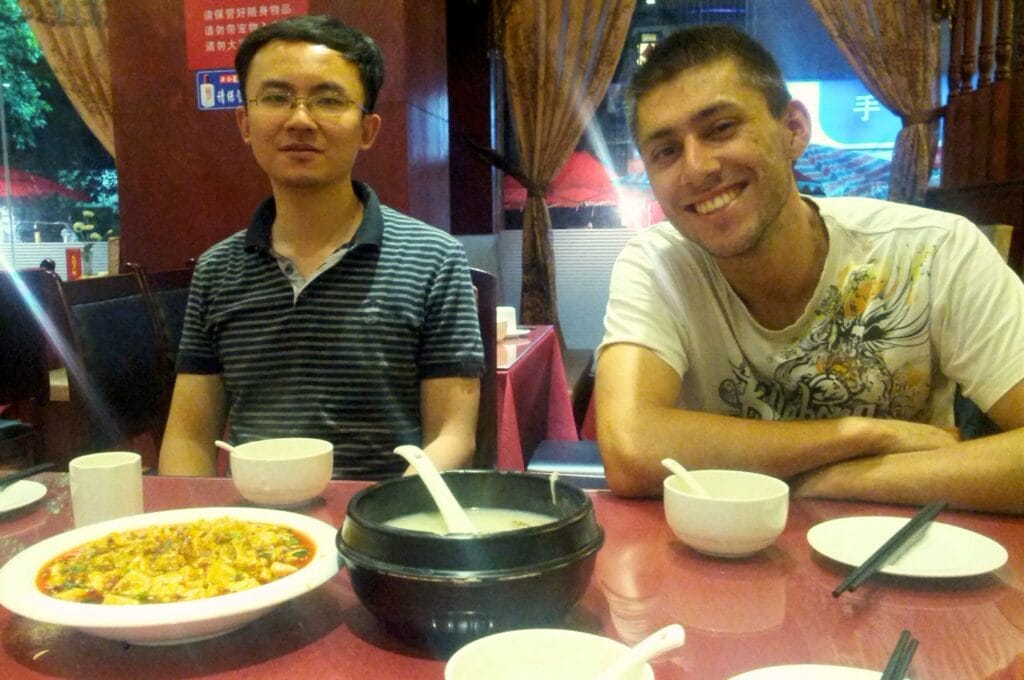
Other activities to do in Chengdu
Honestly, there’s plenty to spend 3-4 days in Chengdu enjoying what the city has to offer! Here are other activity ideas to complete your visit itinerary:
- Visit the world’s largest building and see giant fountains once night falls. Imagine the New Century Global Center, a 1.9 million m2 building that brings together shopping centers, cinemas, hotels, theaters, and amusement parks on 18 floors! Enough to make you dizzy… If you’re in the area, don’t miss the giant bamboo-shaped fountains located east of the huge complex. They’re illuminated in the evening, and it’s quite a unique spectacle!
- In west downtown Chengdu, Du Fu Thatched Cottage Museum deserves a visit if you’re fond of poetry or simply curious. Du Fu was the most famous poet of the Tang dynasty, and the museum was installed in the reconstruction of his cottage. You’ll find explanations in English. It’s an ode to Chinese literature and tranquility: the museum is located right in the middle of lush gardens!
- Visit the Jinsha archaeological site to go back in time and follow traces of the region’s civilization. Here, you’ll be plunged more than 3,000 years back! Many bronze, jade, and ivory relics from the Shu kingdom are displayed. The site is open every day from 9 a.m. to 6 p.m. To go to Jinsha, take metro line 7 and get off at exit C of Jinsha Site Museum Station. Entry costs 70 yuan per adult.
What to do around Chengdu
Sure, 90% of tourists come to Chengdu to see pandas. But there’s plenty of other things to do! And honestly, it would be a shame to stop only at the research center and the city itself. Plan 2 or even 3 days to explore Chengdu’s surroundings.
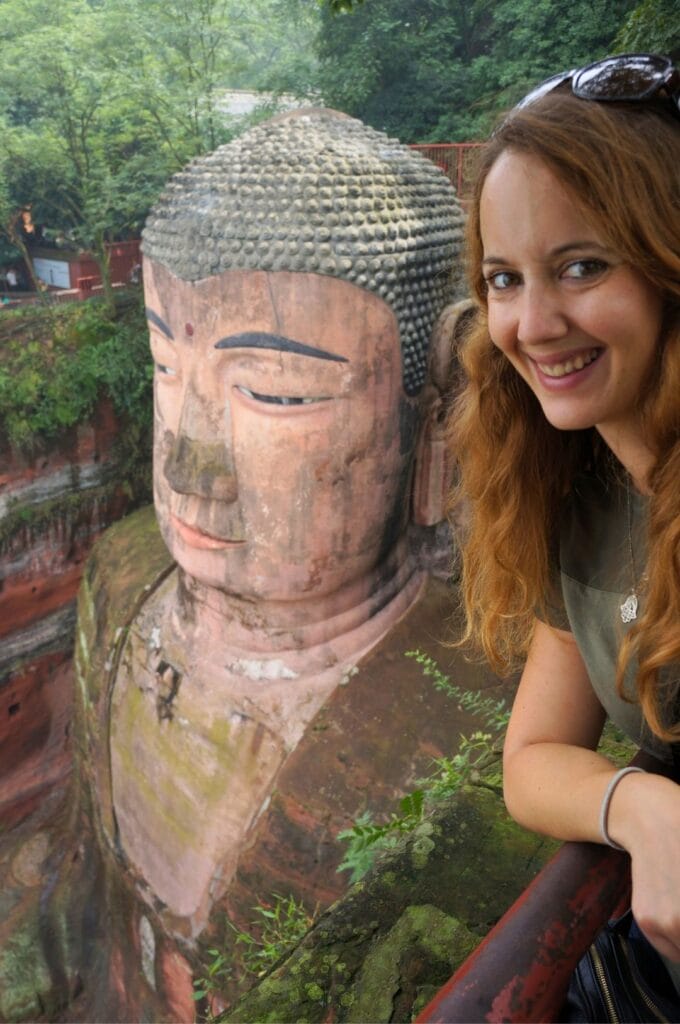
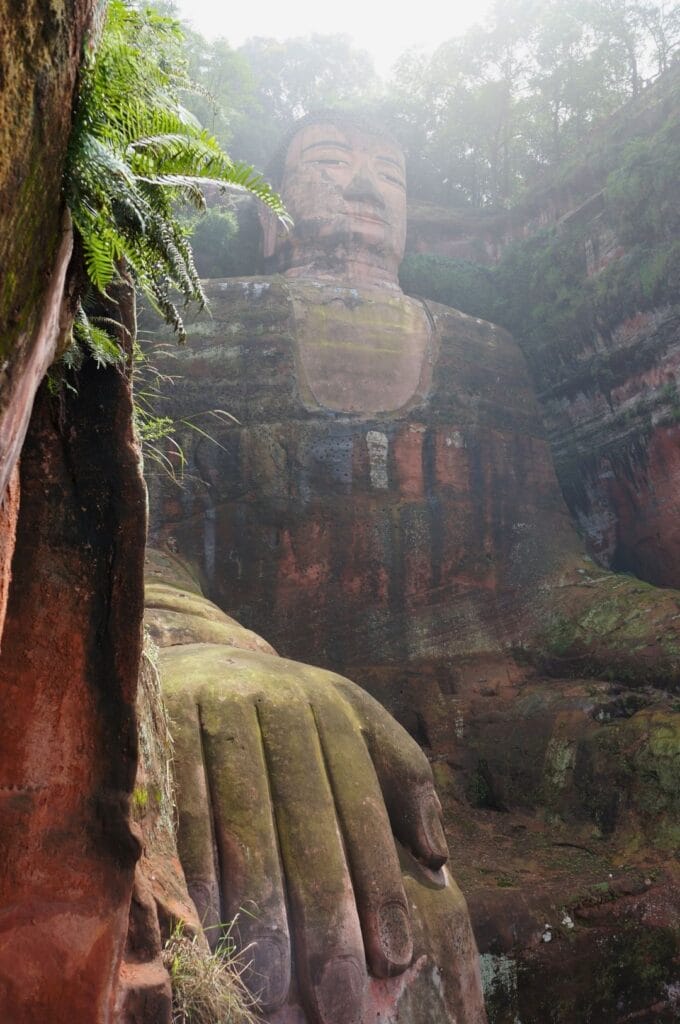
See the Giant Buddha in Leshan
On the way to Mount Emei, don’t miss Leshan Giant Buddha! At 70 meters high, it’s impressive! We explain everything in detail here.
To get there from Chengdu, you can go on your own or take a guided excursion.
More than 20 trains make the journey between Chengdu and Leshan every day. The trip takes about 1 hour and costs between 100 and 140 yuan. Then, from the station, you need to take a shuttle bus to the site entrance.
By bus, it’s longer, and we don’t recommend it since the train is faster and costs barely more.
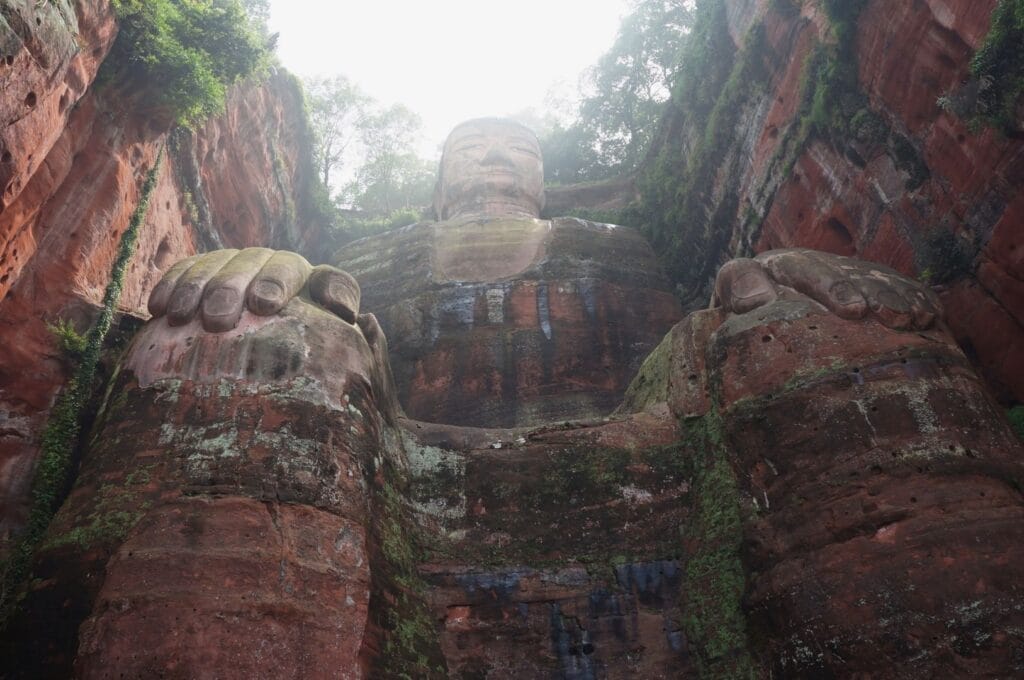
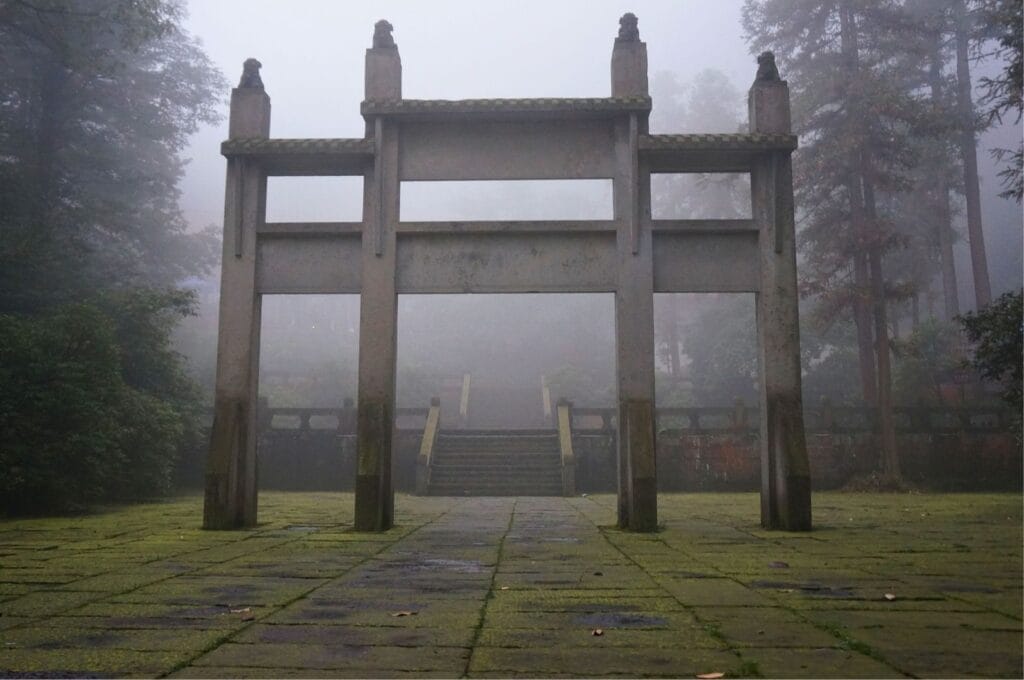
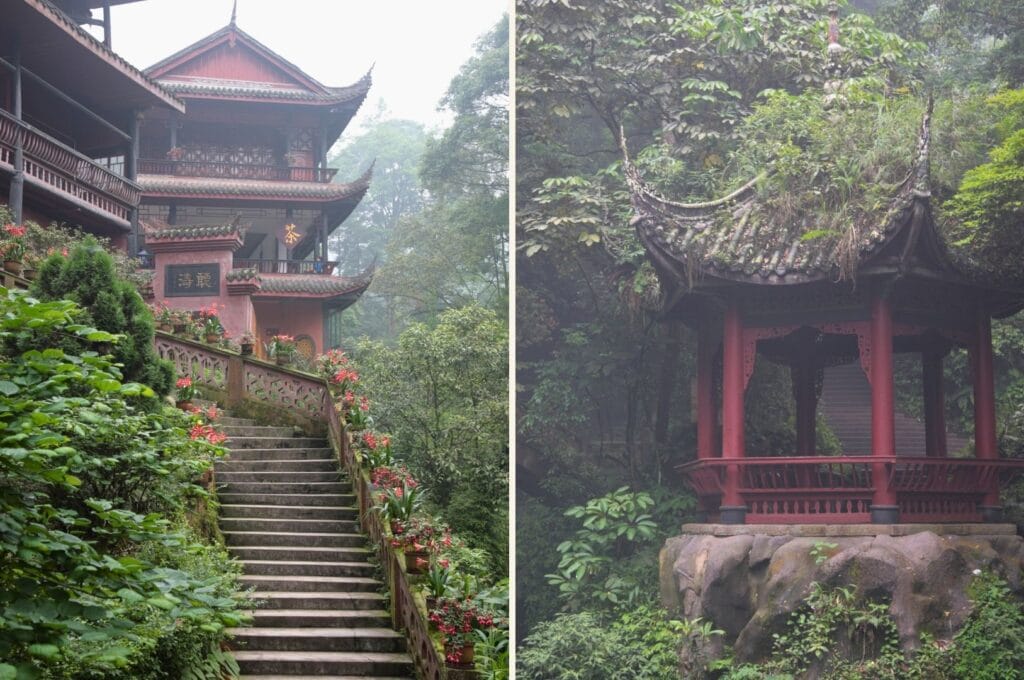
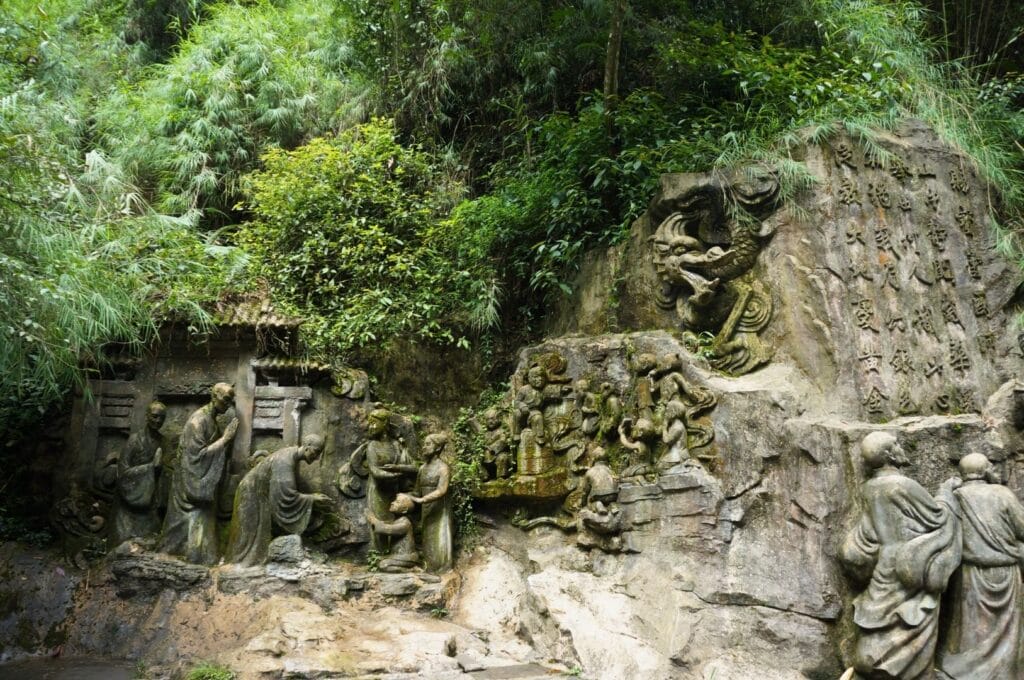
Climb Mount Emei
Are you ready to climb hundreds of steps? Then Mount Emei is waiting for you! This other sacred mountain must be earned, but honestly, it’s worth making your legs work. You can easily find yourself away from tourist groups for a refreshing experience! We wrote a complete hiking guide to Emeishan!
Climb Mount Qingcheng
Leave the city to hike on Qingcheng Mountain, just 100 km from Chengdu. This mountain is considered the birthplace of Taoism, so it’s sacred! We recommend this excursion if you’re thirsty for nature or if you don’t think you’ll do Mount Emei. As with any mountain in China, expect lots of steps! Here too, a cable car has been installed, but it doesn’t spare you from taking the stairs to finish the 7-8 km loop! To compare, the views from Qingchengshan are a bit less panoramic than Emeishan. Here, we’re not as high, but you’ll see many Taoist temples along the trail.
Practical information:
- How to get to Mount Qingcheng: From Chengdu, take a high-speed train (about 1 hour) to Qingcheng station. Once there, taxis or local buses will take you to the parking at the foot of the trail. If you prefer to go with a guide, then we recommend this excursion.
- There are 2 areas for hiking: the front and back of the mountain. We only present the front part here, the most popular.
Visit Dujiangyan and its irrigation system
Right next to Mount Qingcheng, stop at Dujiangyan, a city with an irrigation system listed as a UNESCO World Heritage site! Dating from the 3rd century BC, this system of canals through the city was created to prevent flooding caused by the Min River, but also to irrigate the plain. A true engineering feat, it still works today, just like the first day!
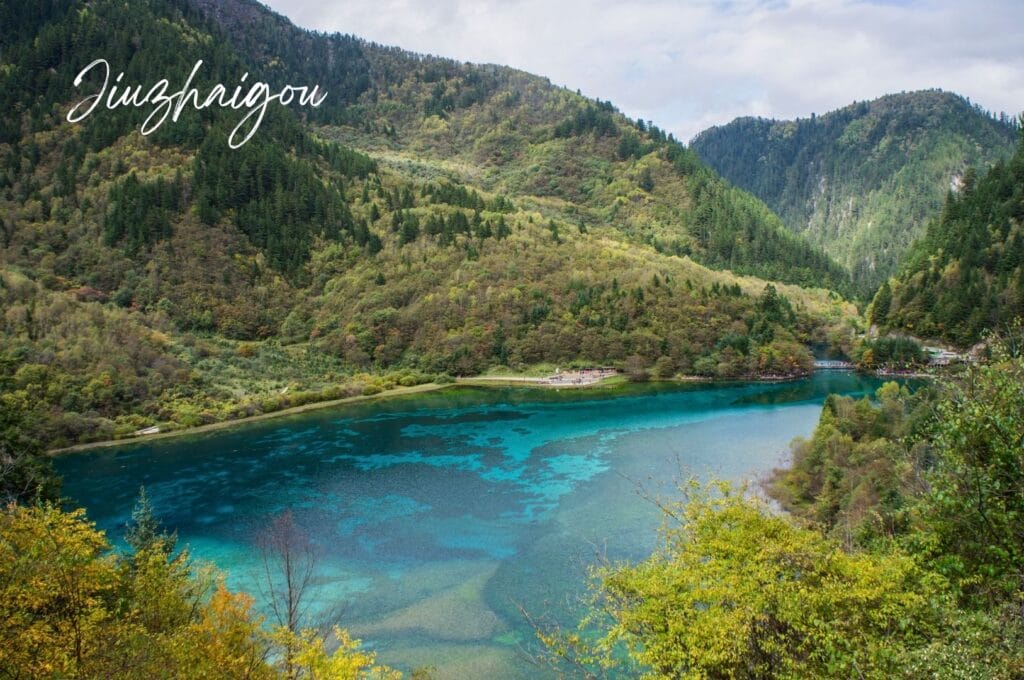
Hike in Huanglong and Jiuzhaigou Valley Park
Although these 2 places are quite far from Chengdu (nearly 300 km), we have to tell you about Jiuzhaigou Valley and Huanglong, 2 of the most beautiful natural places in China, both UNESCO World Heritage sites! We’re still in Sichuan, but in the north, in the mountains, with dozens of turquoise lakes, crystal-clear water basins, and waterfalls, all surrounded by forests… There you are, you’re in paradise!
- How to get to Huanglong and Jiuzhaigou: Unless you take a tour, you’ll have to make the journey by train or plane (1 hour).
- Entry prices: For Jiuzhaigou Valley, tickets cost 250 yuan (book your ticket online) and for Huanglong, the price is 170 yuan in high season (between April and November).
- Hikes: The trails are very well marked and don’t necessarily require good physical condition.
- Beware of altitude sickness! You’ll be between 2,700 and 3,800 meters altitude! Find all our advice for preventing this problem.


If you’re traveling to China and want to access Facebook, Instagram, YouTube, or Google, know that these sites are blocked.
You’ll need to use a VPN during your stay. For our part, we’ve had a subscription with ExpressVPN for several years and are delighted with it!
Our Chengdu experience: final thoughts
There you have it for visiting Chengdu and its surroundings. We really loved this region and can only encourage you to come discover it for yourself! You can see there’s plenty to do over several days ;). Do you have a question? Leave us a comment!
We’re continuing our stay in the Middle Kingdom, and we’ll see you in western Sichuan, between trekking on the Himalayan plateau, discovering yaks and all their assets, spending the night with Tibetan nomads, and how the yak got the better of Ben!
P.S.: Find our complete guide to preparing your trip to China with all our practical tips for visiting the country and our advice for creating your itinerary.
Pin it
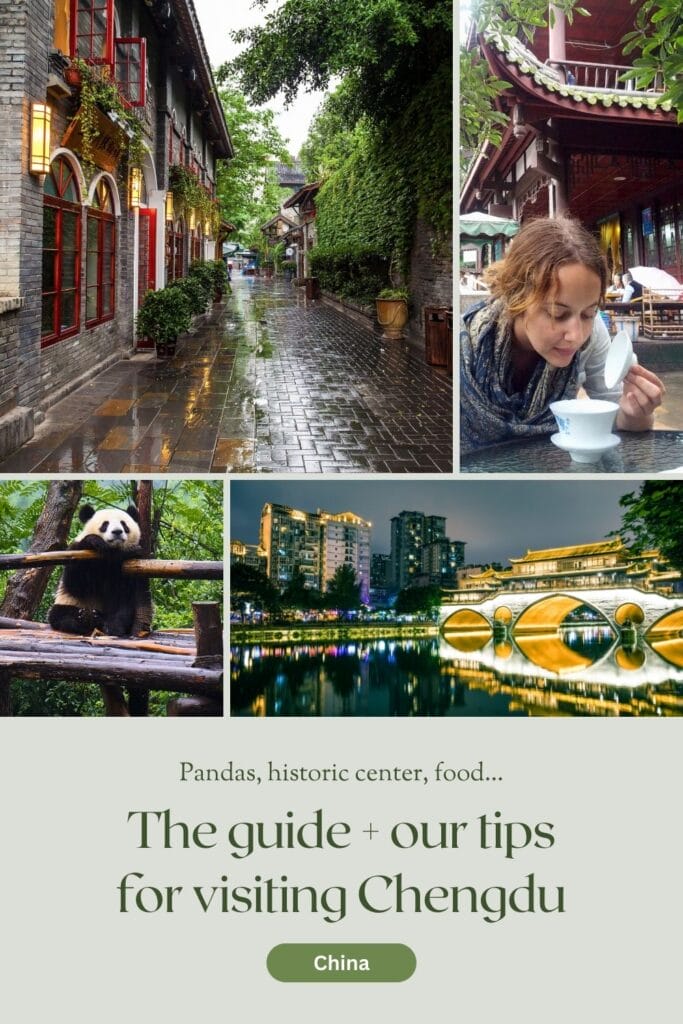


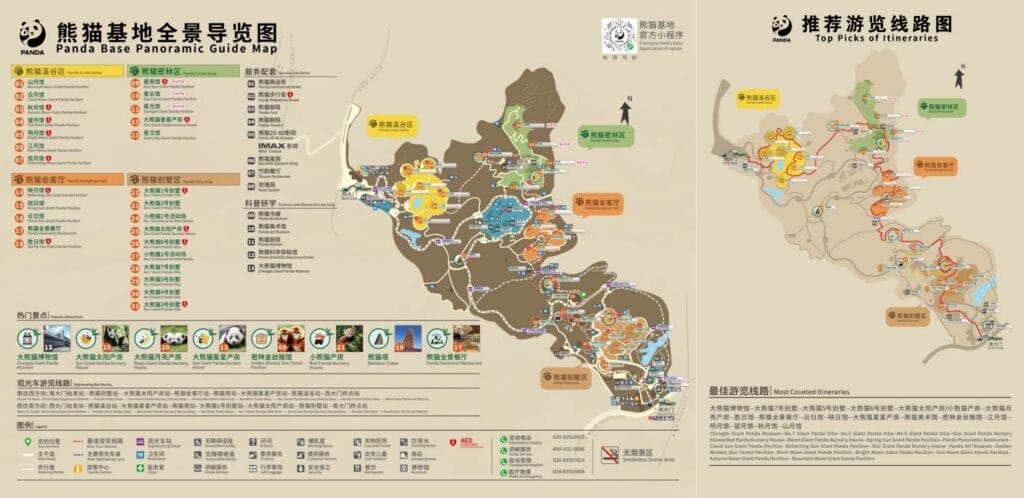
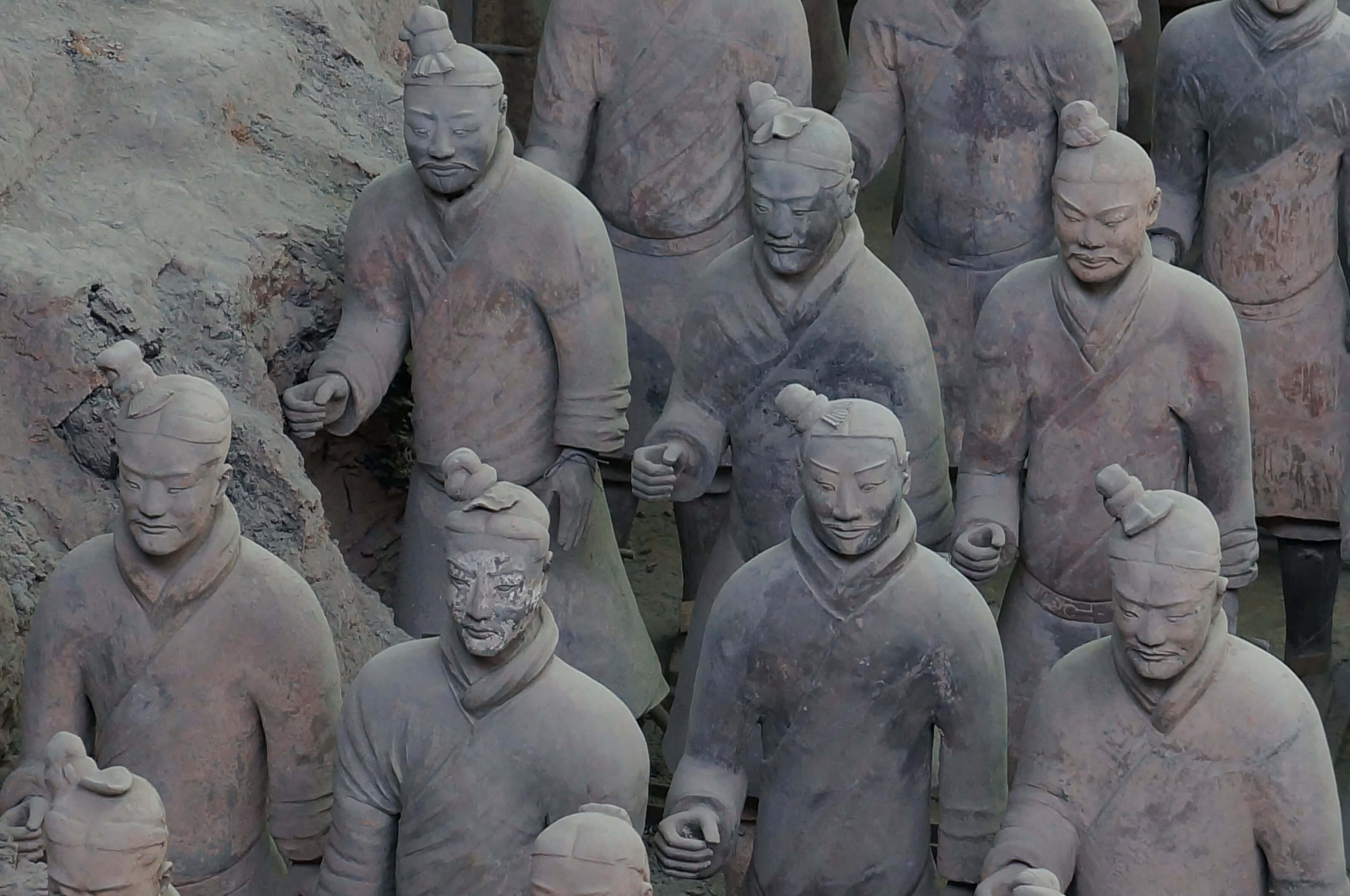
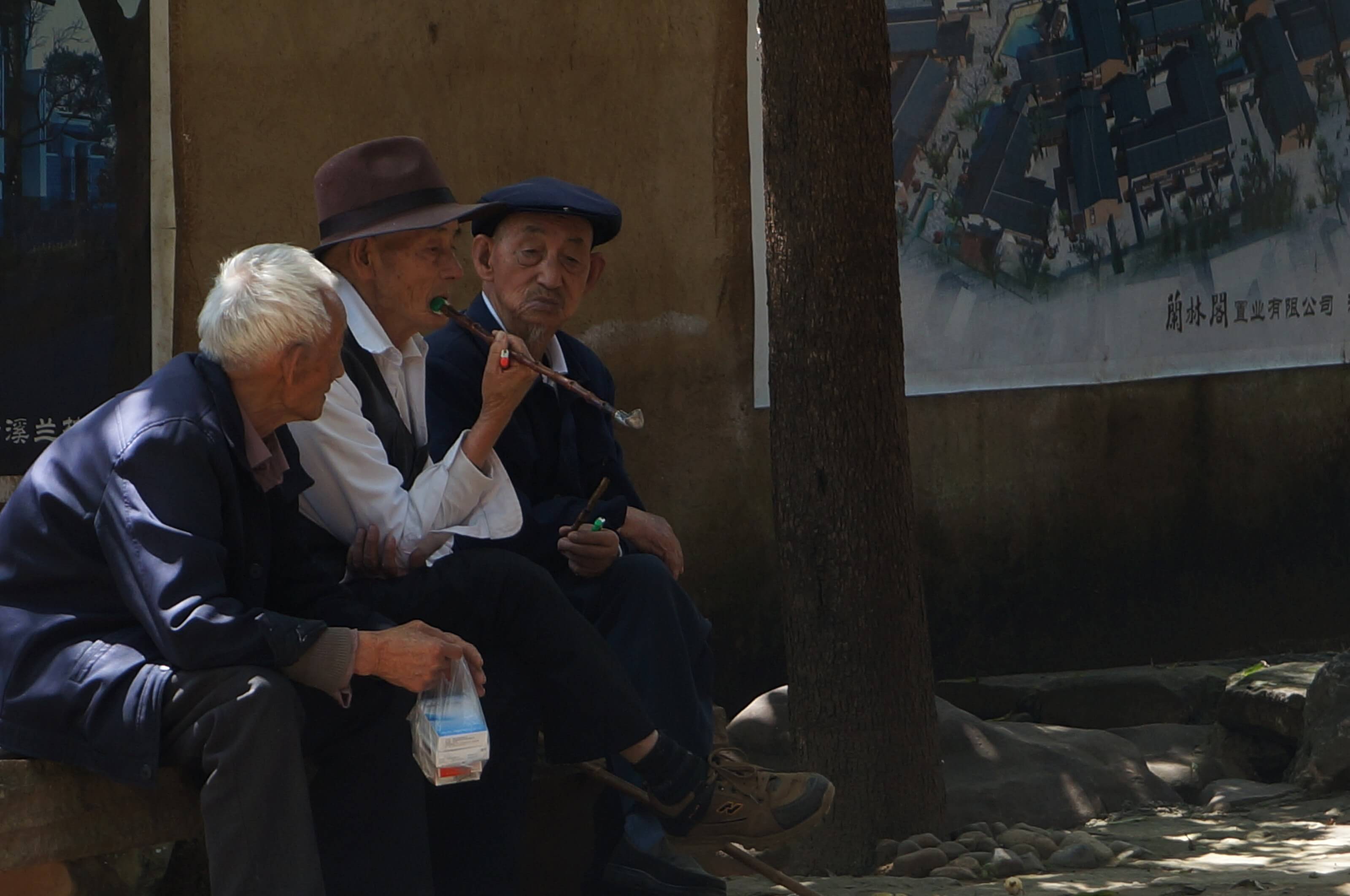
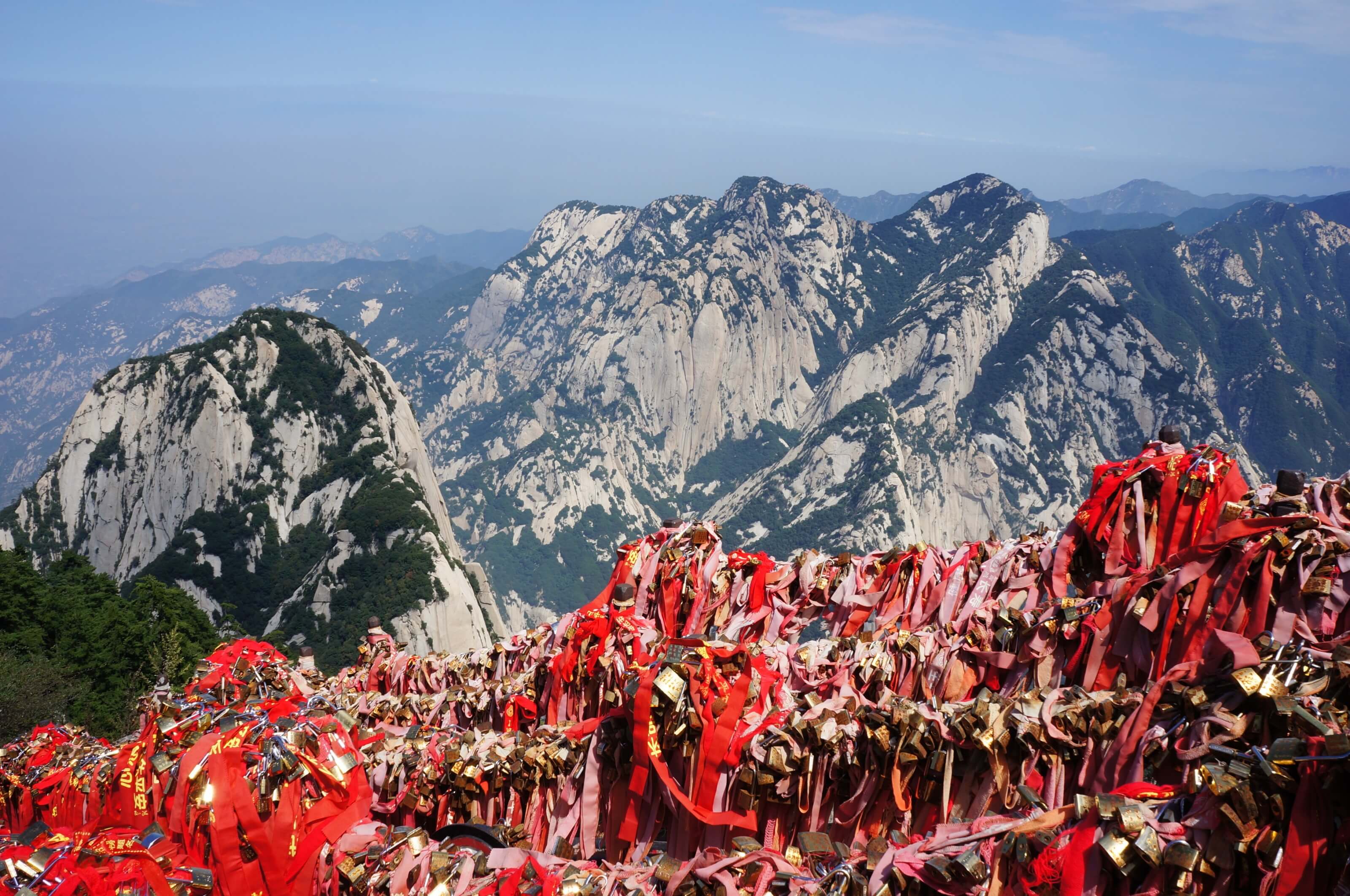
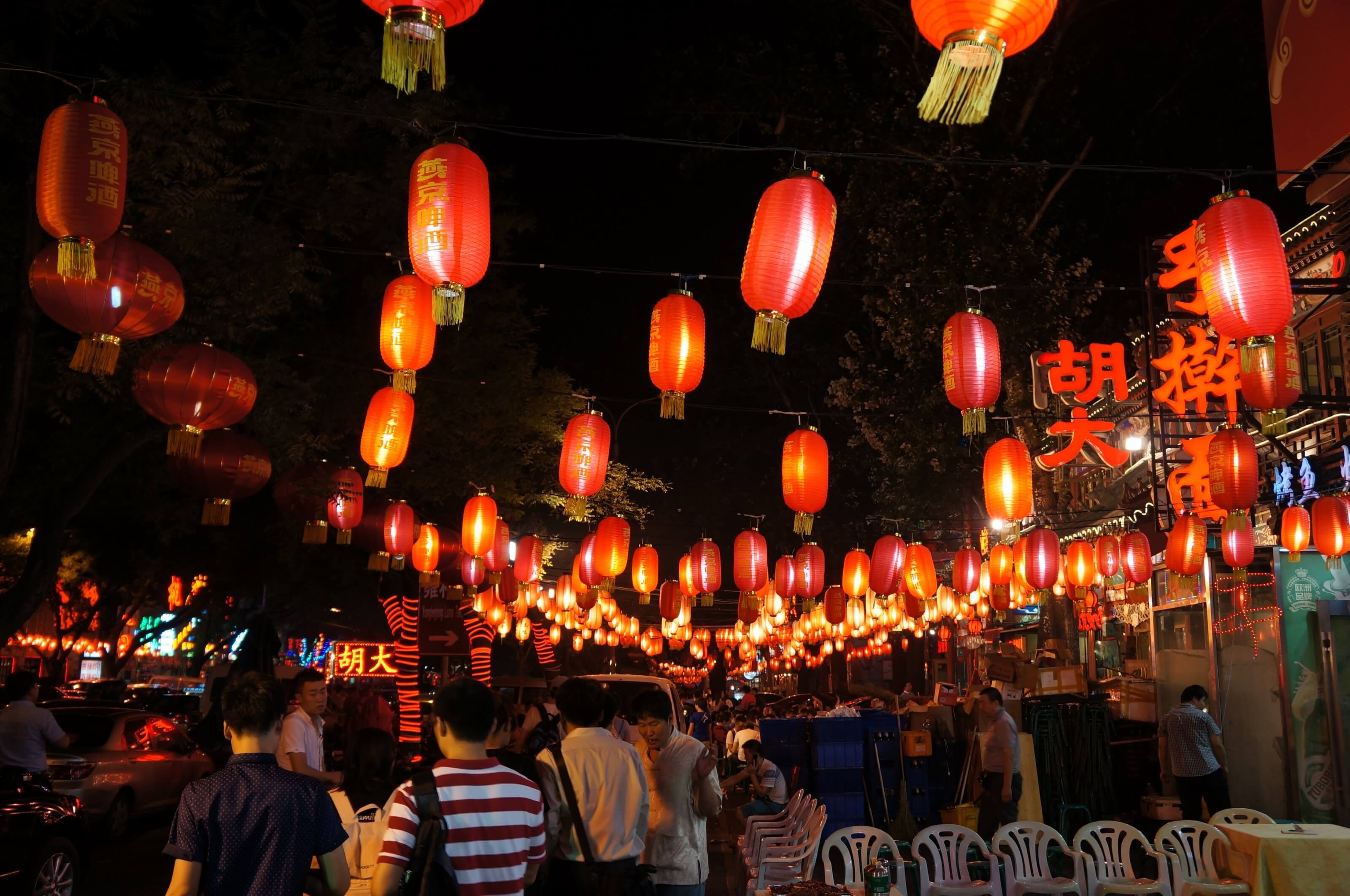
Join the discussion